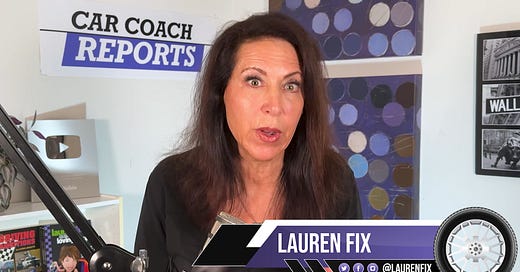What Is the “Chicken Tax” Anyway? And How It Relates to Car Tariffs
By Lauren Fix
You may have heard of the chicken tax, and no it has nothing to do with food, although it did originally. The talk about auto tariffs are a hot topic of conversation, and this is where the existing “chicken tax,” which was put into place 61 years ago, comes into play. You’d have to have been around a long time to remember firsthand when it happened, but even you may not remember exactly why it happened. Here’s what it is and why you should care.
Decades ago in the early 1960s, American’s chicken farms were producing poultry at an all-time high, and while U.S. customers enjoyed plenty of chicken dinners themselves, there was still a surplus. So, the poultry industry looked overseas.
Chicken farming in Europe had not progressed nearly to the extent that it had in America, so its countries became a prime market for exported chicken, as chicken sourced here was far cheaper than European poultry. Chicken suddenly moved from being something special to something normal.
In a story in Time magazine from November, 1962: “Last year the intake of chicken rose 23 percent in West Germany alone. Demand for chicken expanded briskly in the rest of Europe, and U.S. farmers, with shipments worth $45 million, grabbed nearly half of the import market.”
Prices were so low that the European chicken farmers couldn’t compete. Then the blaming started: “The Dutch accused the U.S. of dumping chickens in Europe at prices below cost of production. In Bavaria and Westphalia, protectionist German farmers’ associations complained that U.S. chickens are artificially fattened with arsenic and should be banned. The French government did ban U.S. chickens, using the excuse that they are fattened with estrogen. With typical Gallic concern, Frenchmen hinted that such hormones could have catastrophic effects on male virility.”
Taxes and tariffs were quickly enacted that raised the price of U.S. chicken by as much as 50%, cutting American chicken imports to Europe by 25%. The US government took notice: In Switzerland, US Senator J. William Fulbright from Arkansas interrupted a debate over nuclear weapons for NATO forces to protest European hostility to U.S. chickens.
Inevitably, the talk turned to retaliation, by 1963, U.S. chicken exports were down 67%. President John F. Kennedy joined the conversation, pleading the case that tariffs on chicken imports to Europe should be decreased.
Less than two weeks after President Johnson was sworn in, he enacted Proclamation 3564, with the specific intent of “Increasing Rates of Duty on Specified Articles.” It began like this: “Whereas the European Economic Community maintains unreasonable import restrictions upon imports of poultry from the United States…”
The brief proclamation went on to enact tariffs on imported potato starch and dextrin (another kind of starch), on brandy that was valued “at over $9 a gallon,” and most importantly, on “trucks valued at $1,000 or more.”
Cars could still be imported to the U.S. at the rate of 2.5%, but suddenly imported trucks would be taxed an extra 25%. Shortly after - the tariffs on brandy, potato starch, and dextrin went away, but the truck tax has lingered, and remains in place today, more than six decades later.
Historians insist that the so-called Chicken Tax (the automotive part of it) was a concession to United Auto Workers (UAW) President Walter Reuther, who communicated to the administration that the Big Three were concerned about the importation of light trucks from overseas.
What light truck would that be? Incredibly, it was the rear-engine Volkswagen Type 2 pickup, scarce as hen’s teeth today but back then, apparently present in numbers that frightened Reuther. Likely the concern was more the plethora of Volkswagens in general that were arriving in the U.S., from the Beetle to the Microbus to the Westfalia camper van.
What the Type 2 pickup’s presence did establish was an American appetite for lighter-duty trucks than the Ford, Chevrolet, GMC, and Dodge offerings. Imitation being the sincerest form of flattery, U.S. manufacturers battled back with GM’s VW-like, rear-engine, raised-bed version of the Corvair, called the 95, that came both as a pickup and as an anti-Volkswagen van called the Greenbrier. Dodge answered with the A100, Ford with the Econoline, both of which were available in pickup and van configurations.
The Chicken Tax helped lead to the end of Type 2 pickup importations—not a huge inconvenience to VW, but it was likely lost on no one in Detroit that the Japanese were coming. Manufacturers like Toyota, were quickly rewriting the playbook for the car market and threatened to do so in the truck market, though the company’s first attempt, the little Stout pickup introduced in the U.S. in 1964, made no waves. It wasn’t until Toyota really got serious in 1969 with the Hilux that Detroit began feeling the threat. Fortunately for them, the Chicken Tax was a genuine benefit.
Foreign manufacturers have tried for years to find a loophole in the Chicken Tax. Perhaps the most overt, and actually funny, attempt was by Subaru: The Japanese automaker attempted to import the BRAT, a small pickup that arrived in 1978, and equipped them with a pair of rear-facing, welded-in jump seats. This savvy move allowed the BRAT to be categorized as a passenger vehicle, subject only to a 2.5 percent tariff, rather than the full-fat 25 percent Chicken Tax.
The early Chevrolet LUV small trucks were imported from Japan just as a chassis, minus the bed, which was taxed at 4 percent. The rest of the LUV, including the bed, was finished in America before it was sent to dealers. That loophole was closed in 1980.
What the Chicken Tax arguably did accomplish was having foreign manufacturers build trucks either in the United States or in countries that were at least covered under the North American Free Trade Agreement, which included Canada and Mexico. Today, even smaller pickups are built in the U.S., like the Nissan Frontier (Mississippi) and Toyota Tacoma built in Texas, as well as Baja California, Mexico.
Is the Chicken Tax still needed? That has been debated for 60 years!. Still, the Chicken Tax lives on, likely serving as a template for the new tariffs being enacted right now. How those tariffs might affect the automobile (and chicken) market remains to be seen. But now you know the unlikely precedent.
Today, Mercedes' Sprinter vans dodge the chicken tax too. In a creative exercise in automobile manufacturing that takes place daily inside the old, 350,000-square-foot Western Star truck plant here that is now owned by Daimler. The Mercedes-Benz and Freightliner Sprinter cargo vans are reassembled after being fully built and tested in Dusseldorf, Germany. It’s the “chicken tax” at work.
After the Sprinters are manufactured and ready for export, German workers strip out the drivetrains and fuel systems. The gutted vans are then exported to the Port of Charleston, S.C., vehicle bodies on one ship, mechanical components on another. After clearing customs, the vans and mechanical parts are transported 19 miles to the Ladson plant.
The reassembly process sounds like a logistical and potential quality nightmare. American workers re-install drivetrains and fuel systems in the exact vehicle they were removed from in Germany. Any nuts, bolts or connectors that have been designed to be torqued down once are replaced with identical items shipped from Germany.
Then, the reassembly line workers reconnect the brakes, refill all the fluids and fully retest the vans before they are cleared for shipping to dealers. The only U.S. content in the Sprinter is the battery.
Daimler has a devised a reasonably efficient system. Between 66 and 74 vans roll off the 17-station line five days a week. Each van requires about 3.5 hours of work to reassemble.
During a recent plant tour, Walther Bloch, Sprinter’s chief engineer, said the quality of the reassembled vans is equal to non-chicken tax Sprinters sold in other global markets. The Ladson plant is on track to ship about 23,000 reassembled Sprinters this year.
The gyrations some automakers go through to avoid the 25 percent tariff on imported trucks seems wasteful and crazy. And of course, this makes the vehicles more expensive.
But some of it does make sense. For one thing, automakers can import a light truck and test the market without having to commit to a major assembly plant on U.S. soil. And the 90 people here at the Daimler plant are earning good wages reassembling the vans. So, you know they don’t want any repeal of the chicken tax.
Mercedes Benz says the cost to strip, ship and reassemble adds about 9 percent to the cost of the Sprinter, which starts at $36,990 including shipping, so it saves about 16 percent tax on every van.
Mercedes isn’t the only automaker dealing with the chicken tax. So are Ford and Chrysler.
Ford’s Transit Connect, manufactured in Spain and shipped to the United States as a passenger vehicle, comes with rear seats, seat belts and windows. Once they land at the port in Baltimore, Ford converts about 70 percent of them into cargo vans by removing the seats, windows and seat belts. It is the same strategy Chrysler is gearing up for now with the ProMaster City small van, which is built in Turkey as a passenger vehicle.
And Daimler has added more to their van exports with the new, smaller Metris. Like the Sprinter, it will leave Europe in pieces and be reassembled at the Ladson plant. The Metris will be built in Vitoria, Spain.
Mercedes is hoping to build its U.S. commercial van business to 50,000 units per year. And once it reaches that threshold, company officials say, the door is open to constructing a plant to build Sprinter and Metris. As of today, they’re not there yet, but with Trump‘s new tariffs, this may be something they’re considering.
There have been efforts to repeal the chicken tax over the years, but they have not gotten much traction. Many think the this “chicken tax” is an outdated and nonsense relic of the 1960s. But as always in this industry, nothing is ever that cut and dry.
Now the big question is: will the tariffs push brands like Mercedes-Benz, Ford, and Chrysler as well as many others to start producing their vehicles here in the United States. We have the facilities, we have the people, we just need the incentive.
You can support me by buying me a cup of coffee. Thanks for subscribing and your support! https://www.buymeacoffee.com/laurenfix
Looking for more automotive news?
https://www.CarCoachReports.com
Total Car Score Podcast ► https://www.revolverpodcasts.com/shows/total-car-score/
Lauren Fix, The Car Coach, is an automotive expert. Follow her on X
@LaurenFix for the latest car news and insights.














Share this post